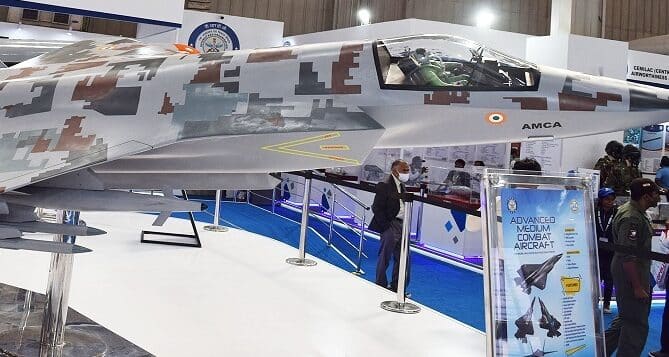Aerospace
5th generation fighter jet AMCA project gets Cabinet Committee on Security approval

India has officially embarked on the development of the Advanced Medium Combat Aircraft (AMCA) with the approval of funding by the Government of India for the fifth-generation fighter jet program. According to government sources, this cutting-edge aircraft will be a collaborative effort between Hindustan Aeronautics Limited (HAL) and the National Aerospace Laboratories (NAL).
The Cabinet Committee on Security, chaired by the Prime Minister of India, has given its green light to the indigenous fifth-generation Advanced Medium Combat Aircraft (AMCA) fighter jet project for the Indian Air Force (IAF), with a budget of USD $1.8 billion. The approval entails the preparation of five prototypes of the AMCA, which will be undertaken by the Defence Research and Development Organisation (DRDO) over the course of the next five years.
India’s much-anticipated AMCA project marks a significant leap forward in bolstering the country’s defense capabilities, propelling it to new heights on the battlefield with cutting-edge 5th generation fighter jet aircraft. Building on the success of the Tejas Mark1 aircraft, which has already left a substantial impact on India’s defense prowess, the AMCA represents the next frontier in India’s quest for technological excellence and military superiority.
The futuristic AMCA boasts a design featuring shoulder-mounted diamond-shaped trapezoidal wings, strategically crafted to minimize drag during transonic speeds. Its stabilatorV-tail, coupled with a large fuselage-mounted tail-wing, ensures optimal stability and maneuverability. Flight control surfaces including flaps, ailerons, and rudders, alongside innovative air brakes, further enhance its performance.
In a groundbreaking leap towards sixth-generation capabilities, the AMCA is envisioned to embrace crew-optional configurations and wield directed energy weapons, effectively commanding UCAVs and swarm drones.
Propelled by two afterburning turbofan engines, the AMCA Mark-1 is set to be equipped with the formidable General Electric F414 engine, while a joint venture engine of heightened power is earmarked for the AMCA Mark-2 variant.
Anticipated to revolutionize aerial reconnaissance, the AMCA will integrate distributed passive sensors, empowered by AI-assisted multi-sensor data fusion, augmenting situational awareness alongside an advanced electronic warfare suite.
Inside the cockpit, innovation takes center stage with a sleek glass cockpit adorned with a panoramic touchscreen display, fostering seamless man-machine interaction. Complemented by a portrait-oriented multifunction display and a wide-angle holographic head-up display, pilots are equipped with unprecedented visibility and control.
With the recent debut flights of South Korea’s KF-21 and Turkey’s TFX, the anticipation grows around India’s potential entry into the league of advanced 5th generation fighter jets. The AMCA, undergoing testing with GE engines initially, holds promise for upgraded features powered by higher-capacity engines in the future. While many countries have expressed interest in joining India’s 5th generation fighter jet program, India has chosen to pursue its advanced aircraft development independently.
India’s commitment to its indigenous Fifth Gen Fighter jet program positions it uniquely on the global aerospace stage, showcasing its prowess in producing cutting-edge aircraft. This strategic move not only boosts India’s defense capabilities but also promises economic growth through advancements in the aerospace sector.

Aerospace
Boeing Transfers Rocket Stage to NASA, Paving Way for Human Moon Mission

Boeing has achieved a significant milestone by providing NASA with the second core stage of the Space Launch System (SLS) rocket.
This crucial component, crafted at NASA’s Michoud Assembly Facility (MAF), is set to propel the Artemis II crew into lunar orbit, marking humanity’s return to deep space after a 50-year hiatus.
The monumental Boeing-built rocket stage, the largest element of the Artemis II mission, will embark on a journey aboard the Pegasus barge, traveling 900 miles to NASA’s Kennedy Space Center.
Comparison of two legendary aircraft B777x vs B747 aircraft:Click here
Upon arrival, it will be meticulously integrated with other essential Artemis II components, including the upper stage, solid rocket boosters, and NASA’s Orion spacecraft within the iconic Vehicle Assembly Building. This intricate integration process is a vital step toward the eagerly anticipated Artemis II launch, slated for 2025.
“Boeing-built products helped land humankind on the moon in 1969, and we’re proud to continue that legacy through the Artemis generation,” remarked Dave Dutcher, vice president and program manager for Boeing’s SLS program. “Together, with NASA and our industry partners and suppliers, we are building the world’s most capable rocket and paving the way to deep space through America’s rocket factory in New Orleans.”
NASA, Lockheed Martin Reveal X-59 Quiet Supersonic Aircraft:Click here
The delivery of Core Stage 2 marks a significant achievement in the evolution of the SLS rocket. Towering over 200 feet and powered by four RS-25 engines, this core stage, coupled with two solid-fueled booster rockets, will generate a staggering 8.8 million pounds of thrust. This immense power is crucial to launching Artemis II and future missions into the vast expanse of space.
The SLS rocket stands unparalleled in its capability to transport both crew and substantial cargo to the moon and beyond in a single launch. Its extraordinary capacity will facilitate the delivery of human-rated spacecraft, habitats, and scientific missions to destinations including the moon and Mars, ushering in a new era of space exploration.
-

 Travel1 week ago
Travel1 week agoAir India to Expand US Operations with Three New Routes After a Decade
-

 Travel2 weeks ago
Travel2 weeks agoWhy We Should Avoid These Stamps in a Passport
-

 Airlines1 month ago
Airlines1 month agoInvestigations Reveal Fake Chinese Titanium in Boeing and Airbus Jets
-

 Tech4 weeks ago
Tech4 weeks agoChina’s CATL Plans 1,800-Mile Electric Plane Launch by 2027
-

 Airport3 days ago
Airport3 days agoTop 10 Largest Airports in the World by Size
-

 Aerospace4 weeks ago
Aerospace4 weeks agoChina’s Fighter Jets Turn Wings into Autonomous Drones
-

 Airlines4 days ago
Airlines4 days agoAir India Rolls Out A350s for Delhi-New York JFK and Newark Routes
-

 Defence3 weeks ago
Defence3 weeks agoBoeing Enhances Chinook with New Engines and Block II Upgrades at $96 Million







